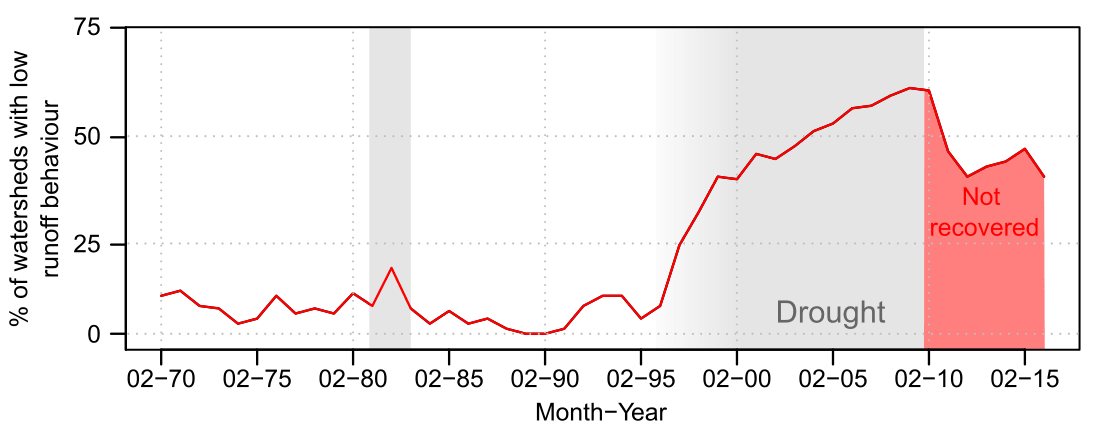The Darling River is again flowing after four years of drought, bringing life and hope to outback NSW. The Menindee Lakes, which form part of the Darling system and were the site of mass fish kills during the drought years, are filling with water, too.
-
Tim Peterson
Senior Lecturer, Civil Engineering
Reports from farmers and Indigenous people who live along the Darling tell of their joy and relief that the river is back. Hydrologists - the scientists and engineers who study river systems - have long believed that river systems will recover fully after drought, and return to normal conditions once the rains come.
But environmental engineer Tim Peterson is challenging that orthodoxy. His groundbreaking research into Victorian rivers after the 10-year Millennium Drought found that more than a third had not recovered.
His findings, which have been published in Science, could have important implications for how watersheds are managed in this country and around the world.
"The Millennium Drought was a very difficult time for farmers and ecosystems, but it provided a fantastic natural experiment, because we had this severe drought, and we've had almost a decade after the drought," he says.
These conditions allowed him to test his theories that watershed runoff doesn't always return to pre-drought levels. (He has not tested the Darling River system.)

Marked reduction in runoff
Nearly eight years after the Millennium Drought ended in Victoria, Dr Peterson found that runoff was up to 30% less in 37% of the watersheds that he tested.
About 80% of these unrecovered watersheds showed no evidence of returning to pre-drought levels soon, suggesting that the low-runoff state could be persistent.
"So, imagine a catchment that doesn't change - the only thing changing is the amount of rain," he says.
Before the drought, 100 millimetres of rain might produce 20 millimetres of stream flow across the catchment.
"When you have a drought, both of them go down - less rain, less stream flow. But then the drought ends and your rain goes back to normal, but your stream flow remains less.
"A portion of the rainfall is now not making it to the stream. And we looked carefully at the fairly disparate bits of data that are available about our land use. Groundwater level was often going down in areas that didn't recover, so that gave us a clue that it's not going to groundwater.
"And so then we used a different statistical approach to show that what appears to be happening is that a greater fraction of the rainfall is being transpired or evaporated by the plants."
This would explain why vegetation remains green even in areas where the catchments didn't return to pre-drought levels.
"It's not that catchments can't recover," he says. After Victoria's drought in 1983, for example, "some catchments shifted, but all of them eventually recovered".
But that hasn't been the case after the Millennium Drought. He's now looking for PhD students willing to research what the rainfall "thresholds" might be that stop some catchments from returning to pre-drought levels.
No disruption from reservoirs
For his Millennium Drought study, Dr Peterson examined rivers and streams in central Victoria (the Loddon-Campaspe region), in the Upper Wimmera, and the Glenelg River in the southwest of the state. He also examined rivers and streams in East Gippsland.
The study, which was conducted with the Victorian Water and Climate Initiative, was conducted on rivers and streams not disrupted by large reservoirs.
"Drier areas are more likely to have not recovered, while alpine areas are more likely to remain unchanged," he says.
"But local patterns overlay that map of wet and dry catchments. So out in the far east of the state, where you have forested catchments, and a fairly wet environment, some of those catchments have not recovered.
Some of the catchments around the greater metro area, that southern bit of the alpine areas have not recovered … You put two catchments next to each other, it's quite hard to say if one will change and recover, and one will not. It's dependent upon very local things about the soils and the size and shape of the catchment."

What's behind the reduced flows?
So what's responsible for the lower water flows?
The paper ruled out some factors that do not contribute. "We looked at obvious possible explanations such as a change in the land use, so if the areas become more forested or less forested."
He found the amount of tree cover made no difference.
Dr Peterson doesn't know what could reverse the phenomenon - although theoretical work suggests exceptionally heavy and prolonged rainfall might do the trick.
His work with the Victorian government is focused on how to manage the state's existing water resources. Almost all of the state's water comes from stream flow.
Climate change isn't responsible, Dr Peterson says. But his research does show that variations in rainfall patterns can affect stream flow - and climate change is expected to make weather patterns more variable than in the past. This potentially means that "it becomes easier to cross a threshold into a low-runoff state and move down, and maybe it becomes much harder to recover".
Implications for drought-vulnerable regions
The research has global implications, he says, particularly for California and parts of China that are also vulnerable to drought.
"Catchments are much more complex than we thought," he says. The bottom-line finding is that "hydrological droughts [in rivers and streams] can continue long after the meteorological drought."
The Millennium Drought is regarded as one of the worst droughts to hit Australia in its modern history. It crippled the Murray-Darling Basin, and placed extreme pressure on ecosystems, agricultural production and urban water supply in the southeastern part of the country. It ended with a La Nina weather event in 2010.






